Here are some modern rare Canadian coins that are very valuable and worth a lot of money. One of the most fascinating areas of coin collecting is finding what are known as “error” coins.
These coins are the result of a mistake made by the mint during their production and collectors go crazy for them.
In the past decade and a half, the Royal Canadian Mint (RCM) has made some pretty cool mistakes. This article looks at some of them.
How A Coin Is Made
To understand how mistakes can be made during the minting process it’s important to understand how coins are made.
Coins are made by taking a flat, round piece of metal called a planchet and striking it with a die. A die is a piece of metal that has an image and/or text engraved on it.
Once the die strikes a planchet, the image is stamped on it. There are dies for the front, or the reverse side, of a coin and separate ones for the back, or obverse side, of a coin.
The one type of error coin that I find to be the most interesting is where the dies get mismatched and stamped on a planchet. The resulting error coin is referred to as a “Mule.”
Many of these so-called mules account for the majority of modern rare Canadian coins. Below are some of the most famous error “mule” coins ever made by the RCM.
1973 Large Bust Quarter
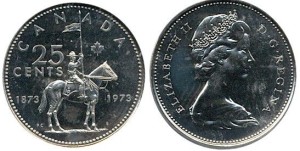
1973 Large Bust Quarters are sought after and sell anywhere from $150-$600, depending on condition.
In 1973, to commemorate the centenary of the Royal Canadian Mounted Police (RCMP), the RCM struck commemorative quarters that feature a “mountie” on his horse holding a flag.
The back side of the coin (obverse side) featured a smaller, more detailed effigy of the queen. Millions of these coins were minted but about 8-10 thousand were struck with a the back side of the 1972 quarters.
1993 Canadian Quarter with 1867-1992 Obverse
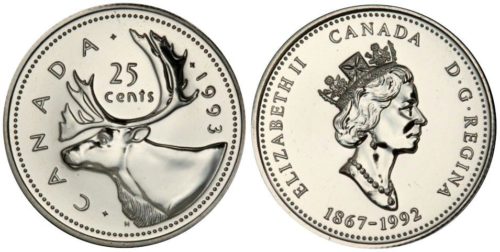
So far only 2 of these rare coins are known, making this one of the rarest Canadian coins ever. A 1993 Caribou reverse was paired with an 1867-1992 reverse that was used on the 1992 provincial coins issued by the RCM to commemorate Canada’s 125th birthday.
In 2017 the highest graded example (a PCGS PL-68) sold at auction for $24k! An ICCS graded MS-66 example sold in a 2015 auction for over $17k. So if you or someone you know has any mint sets from 1993, it’s definitely worth taking a look for this coin!
Millennium Quarters
To celebrate the new millennium, the RCM issued a new quarter each month in 1999 and 2000. The front of the 1999 quarters all featured designs that represented Canada’s past, while the front of the year 2000 quarters featured designs that represented Canada’s dreams for a new millennium.
As can be seen in the picture below, the designs took up all the space on the front of the coins so the denomination of “25 cents” was placed at the back below the Queen’s effigy.
The traditional caribou quarter for 1999 was only issued in mint sets. None were ever produced for general circulation. As can be seen in the picture below, these quarters feature the iconic caribou on the front of the coin, along with the denomination of “25 cents.” On the back of the coin is the Queen’s effigy.
All of these different coins, of course, contributed to the making of the 1999 error coins.
1999 September and November Mule Quarters
Not surprisingly, the busy production schedule resulted in some interesting error “Mule” coins. The coins are “mules” because the front of one coin is paired with the back of another.
These error coins were confined to the special collector sets that were made in Ottawa. No known business strikes have ever been found to exist.
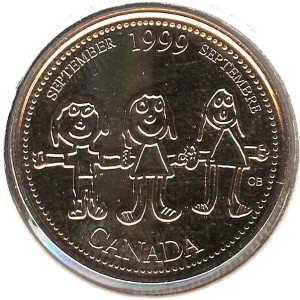
Both the September and the November mules feature the original design on the front of the coin but instead of having the effigy of the Queen along with the denomination on the back, they were paired with the Caribou quarter back sides as shown below.
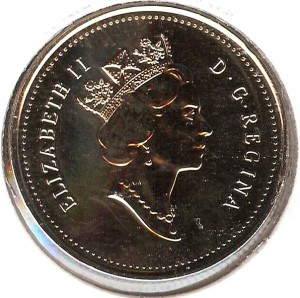
The resulting error produced coins that had no denomination! These fun and highly collectible coins can be found for about $150-$400.
2000 Millennium Map Mule
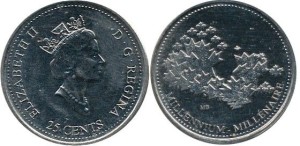
In the year 2000, the mint once again produced special commemorative sets with 12 quarters (1 for each month). The sets are notable for the millennium celebration token in the middle of cardboard display.
In similar fashion to the 1999 sets, the mint again produced a “mule” coin. What made this one especially interesting from a collector’s point of view, was that it involved pairing the front of the millennium token with the back of a February millennium quarter.
This error essentially created a “new” quarter as the millennium token was now stamped with a denomination of “25 cents” on the back.
Another interesting feature is there is no date on the coin. It’s estimated that there are no more than a few hundred of these rare examples in existence. These coins sell for $300-$800.
2007-2010 Olympic Quarters
As Canada prepared to host the 2010 Winter Olympics and Paralympics in Vancouver, the mint produced commemorative coins to celebrate. As was the case with the earlier millennium quarters, mismatched dies created more “mule” error coins.
By far, the rarest and most sought after by collectors is the 2007 Wheelchair Curling quarter.
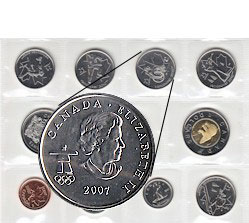
The error on this coin has to do with the Olympic logo being placed on the back of the coin instead of the Paralympic logo.
The mistake was confined to the special edition sets and it is believed that fewer than 700 of these coins exist, making them highly sought after by collectors. These coins fetch anywhere from $400-$700.
The second Olympic “mule” coin had to do with the date on the Alpine skiing quarters. The date on most of these quarters is 2007, however, some of the quarters made specifically for sale at Petro-Canada locations were dated 2008.
The mint decided not to recall these coins so there are tens of thousands of these coins and they only sell for about $15.
2000 “P” Coins
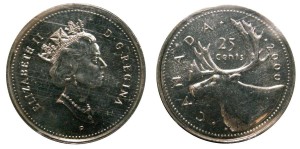
The second major type of modern rare Canadian coins were released in very small quantities in the year 2000 and have “P” mint mark on the reverse.
At the turn of the millennium, the mint began to experiment with nickel-plated steel coins. Up to this point, quarters were made of nickel.
These coins are noteworthy because they are marked with a small “P” on the back.
Nowadays these coins marked with the “P” are everywhere, but back in 1999-2000 they were experimental coins.
The mint released a few millennium quarters with a “P” on them, as well as a couple of Caribou quarters.
These coins are exceedingly rare with about 5 each of the millennium and only 2 known examples of the Caribou. In mint state, these coins have sold for as much as $12-$15k.
There is also a rare 2000P dime as shown below. Some of these examples have sold for as much as $10k.
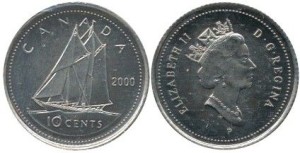
Do You Have Any Rare Coins? What Are They Worth?
For more information about Rare Canadian coins and what they’re worth check out these titles from Amazon:
James A. Haxby’s A Guide Book of Canadian Coins
For Canadian Coin Values and Prices See Charlton Coin Guide.
Protect and Preserve Your Coins
It’s no secret that the most valuable coins are ones that are well preserved. I highly recommend using the individualized 2×2 coin holder. I’ve used them for years for my own coins and they can be kept in a special coin album.
Thanks for reading my post on modern rare Canadian coins. If you’ve enjoyed this article, check out my other coin articles:
oh yeah!
error coins are pretty fun – especially if you find them in circulation!
a friend found a US penny stamped on a dime (or maybe it was the reverse?) and it’s worth quite the *ahem* penny.
always gotta keep your eyes open! 🙂 a great hobby to get into too – I’ve loved being a collector.
in fact, here’s my coin blog if anyone’s interested (shameful plug, sorry!): http://cointhrill.com
Is the coloured petro can quarter with the 2007 date more rare than the coloured petro can quarter with the 2008 date. This is the Alpine skiing coin
Hi, the one dated 2008 is the rare error coin. You can buy them for about $15 new in package. I think about 30,000 were produced and the RCM didn’t bother recalling them.
The mint produced 30,000 of the coloured mule Petro Can 2008 Skiing coins on a card for distribution at gas stations. They made a correction and produced only 10,000 of these coloured Petro Can coloured coins with the 2007 date. This one is the harder one to find. Am I correct thinking this is the rarer coin.
I’m not aware of this coin. I haven’t seen one in coin shops or at any auction. From what I’ve read on the coin forums, there were suspicions that a coloured 2007 was placed in the 2008 holder. My understanding is that the packages aren’t exactly tamper proof and can easily be resealed. In case I’m wrong though, you might want to check with your local coin dealer.
Yes this is a strange one. Typically the mule coin is the more valuable one, but in this case the vast majority of coins produced were the mules. That makes the regular issue the more valuable one…
I have two of the Canadian 1973 Large Bust Quarters send me a email if interested
Thanks but I already have a few myself.
I just found a loonie from 1996 where the Queen on the back looks as though it was double stamped while
the coin was shaking making the coin more dimensional and a bit rough on that side, which is what alerted me to it. Do you know of any more of these?
I’m not sure I have heard of this error. Certainly double stampled error coins exist, I just haven’t heard of the 1996 loonie being one of them.
I have a 5 cent with *p* on it 1952-2002 date on it
and a 10 cent with *p* on it dated 1952-202
are they worth anything
No, those just commemorate the Queens Golden Jubilee. Millions were struck and circulated.
I have probob;y over 100 error coins that I have enherited all Canadian coins even a 2000p cherios coin that has a huge error who can I trust that is well known and trust worth that I can send them to have them prices and maybe even sold
If you’re looking to have them professionally graded, try contacting ICCS (International Coin Certification Service). They are located in Toronto. In my experience with them, they’ve been very good at conservatively grading coins and are well respected among collectors.
I’m the proud owner of 2 2017 Glow In The Dark toonies one of witch is a very obvious struck through and the other also being a off center laminate error but not the little tiny offset but the offsetting goes well over. Both coins have been graded. I hope to aquire more error coins in the future as I find them extremely fun to collect.
I found a 2005 quarter on a copper planchet. Planchet is size and thickness of quarter and is a full and nice strike on both sides. Any ideas
Never heard of this one.
Not surprised to hear it hasn’t been reported. The vast majority of wrong planchet errors aren’t catalogued anywhere because there are so many unique combinations. If every case is unique, coin dealers have zero chance of ever having them for sale, therefore the cataloguing companies don’t have much interest in researching and listing them.
Hi, I have a 2009 MENS HOCKY MASCULIN CANADIAN QUARTER.
It has the Olympic sign on the front with the hockey guy with arms in air holding stick. I have 2 questions, one prolly obvious possibly same as the other but I ask , what do the tiny little letters JB on the right side middle of the quarter represent? also I’d like to ask, there is the date ‘2002 on the front of the same quarterbut the second “2” is stamped across *the players* right leg?? It looks like a terrible mistake lol any info on this ?
Hi Jacob, I’m not sure. You could Google the coin or pick up a coin guide somewhere. If it’s an error coin, it might be worth your time taking it into a coin shop to have it appraised.
I hate to break it to you but you don’t have an error coin:
– Jason Bouman was the artist chosen to design the reverse for all three of the 2009 “Golden Moments” series of quarters. Those are his initials.
– The 2 on the players leg is perfectly normal and was designed that way. Although partway through the production run they changed the design, resulting in two versions:
– the “Raised 2” where the 2 is laid on top of the leg, and
– the “Incused 2” where the 2 has been engraved into the leg.
You can see photos of both versions on my coin club’s web site. Just load this link and scroll down to 2009:
http://www.saskatooncoinclub.ca/articles/06a_25_cent_reverse.html
Lots of other Canadian coin articles are available there too. Here is the main article index:
http://www.saskatooncoinclub.ca/articles.html
Looking for info on canadian 25 cent saskatchewan 1992 coin with reversed stamped back side.all I found was 5 coins known. No value…